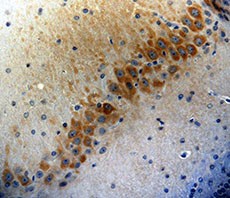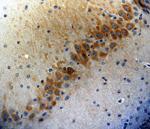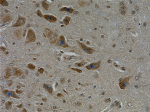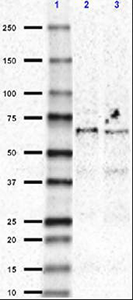- Clone
- N133/21 (See other available formats)
- Regulatory Status
- RUO
- Other Names
- Regulator of G-protein signaling 14, RAP1/RAP2-interacting protein
- Previously
-
Covance Catalog# MMS-5248
- Isotype
- Mouse IgG2a, κ
- Ave. Rating
- Submit a Review
- Product Citations
- publications

-

IHC staining of anti-RGS14 antibody (clone N133/21) on formalin-fixed paraffin-embedded rat brain tissue. Following antigen retrieval using Sodium Citrate H.I.E.R, the tissue was incubated with the primary antibody at 10 µg/mL overnight at 4°C. BioLegend's Ultra Streptavidin (USA) HRP Detection Kit (Multi-Species) was used for detection followed by hematoxylin and bluing solution counterstaining, according to the protocol provided. -

IHC staining of anti-RGS14 antibody (clone N133/21) on formalin-fixed paraffin-embedded mouse brain tissue. Following antigen retrieval using Sodium Citrate H.I.E.R, the tissue was incubated with the primary antibody at 10 µg/mL overnight at 4°C. BioLegend's Ultra Streptavidin (USA) HRP Detection Kit (Multi-Species) was used for detection followed by hematoxylin and bluing solution counterstaining, according to the protocol provided. -

Western blot of anti-RGS14 antibody (clone N133/21). Lane 1: molecular weight marker; Lane 2: 20µg of mouse brain lysate; Lane 3: 20µg of rat brain lysate. Blots were incubated with 10 µg/mL of primary antibody overnight at 4°C, followed by incubation with horseradish peroxidase labeled goat anti-mouse secondary antibody. Enhanced chemiluminescence was used as the detection system.
Regulator of G protein Signaling 14 (RGS14) modulates G-protein signaling by binding to G alpha subunits bound to GTP, converting GDP to GTP, and allowing G alpha subunits to bind to G beta/gamma subunits, which are inactive as a G protein.
Product DetailsProduct Details
- Verified Reactivity
- Mouse, Rat
- Antibody Type
- Monoclonal
- Host Species
- Mouse
- Immunogen
- This monoclonal antibody was raised against a fusion protein corresponding to amino acids 1-544 (full-length) of rat RGS14.
- Formulation
- Phosphate-buffered solution.
- Preparation
- The antibody was purified by affinity chromatography.
- Concentration
- 1 mg/ml
- Storage & Handling
- This antibody should be handled aseptically as it is free of preservatives such as Sodium Azide. Store this antibody undiluted between 2°C and 8°C. Please note the storage condition for this antibody has been changed from -20°C to between 2°C and 8°C. You can also check the vial label or CoA to find the proper storage conditions.
- Application
-
IHC-P - Quality tested
WB - Verified - Recommended Usage
-
Each lot of this antibody is quality control tested by immunohistochemical staining.
The optimal working dilution should be determined for each specific assay condition.
• WB: 5-10 μg/ml
• IHC: 5-10 μg/ml
Tissue: Formalin-fixed Paraffin-embedded tissues
Pre-treatment: Citrate
Primary incubation: 24 hours at 4°C - Application Notes
-
This antibody is effective in immunoblotting (WB) and immunohistochemistry (IHC).
*Expected Molecular Weight = 60 kD
WB positive control: Rat and mouse brain membrane lysates. This clone does not cross-react with human RGS14 in WB.
IHC positive control: Rat and mouse brain tissue. - Product Citations
-
- RRID
-
AB_2564854 (BioLegend Cat. No. 821801)
Antigen Details
- Structure
- Expected MW: 60kD
- Biology Area
- Cell Biology, Neuroscience, Synaptic Biology
- Molecular Family
- Postsynaptic proteins
- Gene ID
- 114705 View all products for this Gene ID
- UniProt
- View information about RGS14 on UniProt.org
Related Pages & Pathways
Pages
Related FAQs
Other Formats
View All RGS14 Reagents Request Custom Conjugation| Description | Clone | Applications |
|---|---|---|
| Purified anti-RGS14 | N133/21 | IHC-P,WB |
Compare Data Across All Formats
This data display is provided for general comparisons between formats.
Your actual data may vary due to variations in samples, target cells, instruments and their settings, staining conditions, and other factors.
If you need assistance with selecting the best format contact our expert technical support team.
















Follow Us